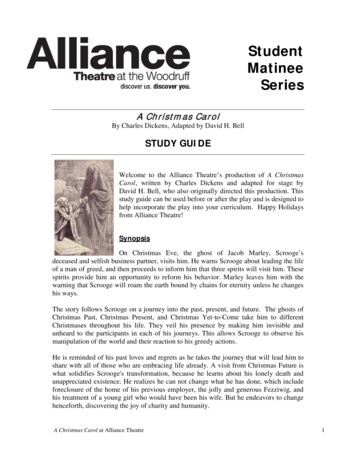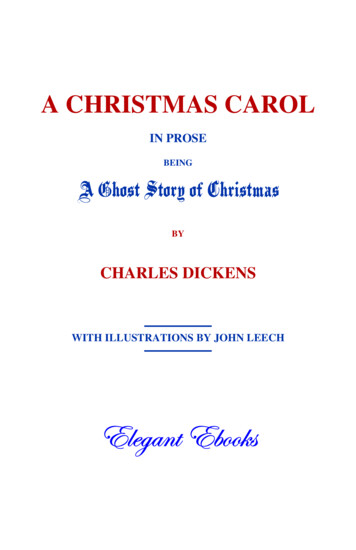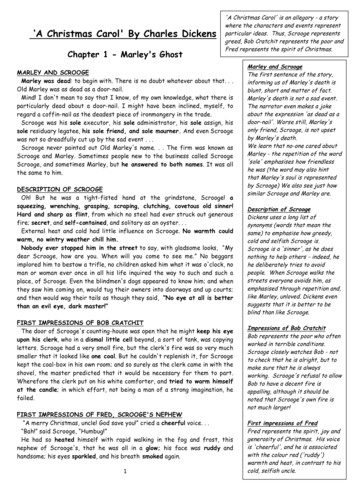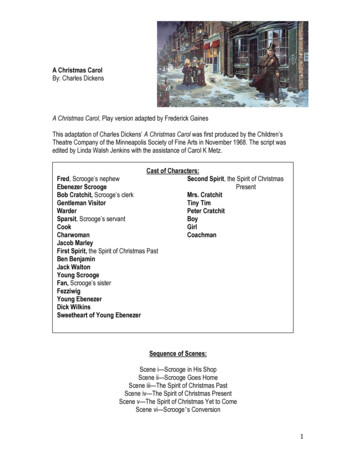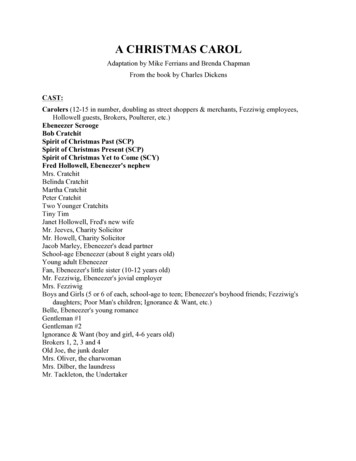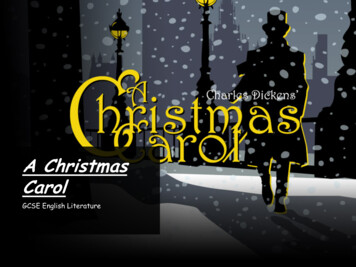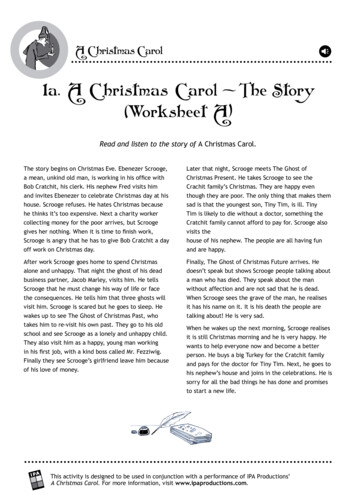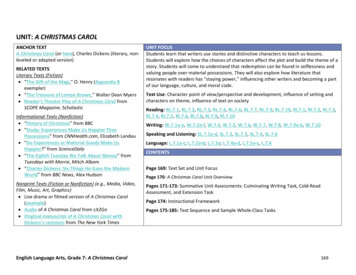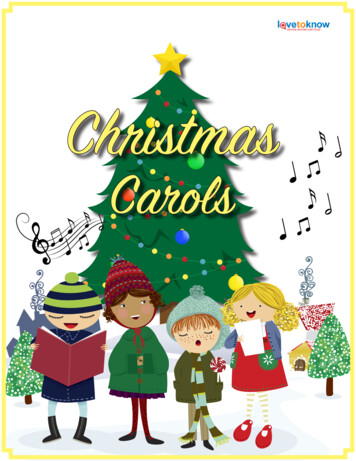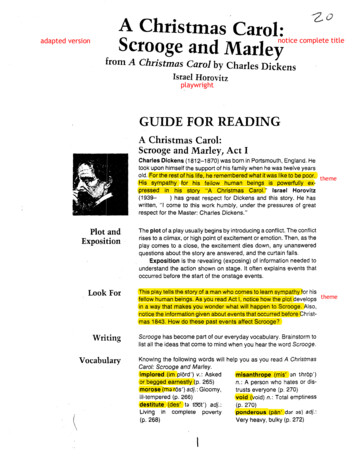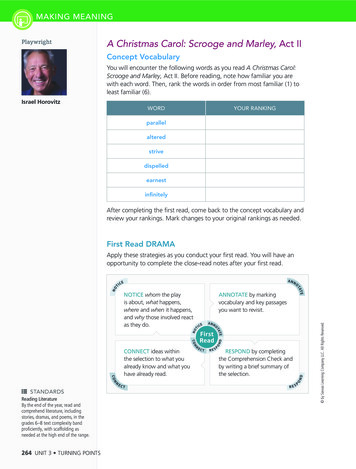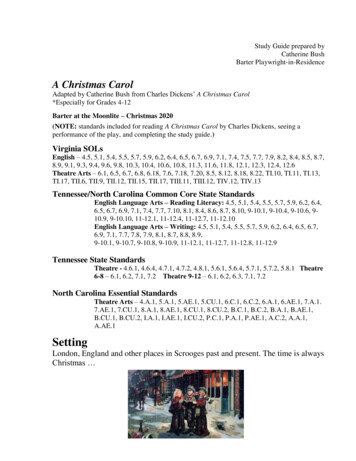
Transcription
Study Guide prepared byCatherine BushBarter Playwright-in-ResidenceA Christmas CarolAdapted by Catherine Bush from Charles Dickens’ A Christmas Carol*Especially for Grades 4-12Barter at the Moonlite – Christmas 2020(NOTE: standards included for reading A Christmas Carol by Charles Dickens, seeing aperformance of the play, and completing the study guide.)Virginia SOLsEnglish – 4.5, 5.1, 5.4, 5.5, 5.7, 5.9, 6.2, 6.4, 6.5, 6.7, 6.9, 7.1, 7.4, 7.5, 7.7, 7.9, 8.2, 8.4, 8.5, 8.7,8.9, 9.1, 9.3, 9.4, 9.6, 9.8, 10.3, 10.4, 10.6, 10.8, 11.3, 11.6, 11.8, 12.1, 12.3, 12.4, 12.6Theatre Arts – 6.1, 6.5, 6.7, 6.8, 6.18, 7.6, 7.18, 7.20, 8.5, 8.12, 8.18, 8.22, TI.10, TI.11, TI.13,TI.17, TII.6, TII.9, TII.12, TII.15, TII.17, TIII.11, TIII.12, TIV.12, TIV.13Tennessee/North Carolina Common Core State StandardsEnglish Language Arts – Reading Literacy: 4.5, 5.1, 5.4, 5.5, 5.7, 5.9, 6.2, 6.4,6.5, 6.7, 6.9, 7.1, 7.4, 7.7, 7.10, 8.1, 8.4, 8.6, 8.7, 8.10, 9-10.1, 9-10.4, 9-10.6, 910.9, 9-10.10, 11-12.1, 11-12.4, 11-12.7, 11-12.10English Language Arts – Writing: 4.5, 5.1, 5.4, 5.5, 5.7, 5.9, 6.2, 6.4, 6.5, 6.7,6.9, 7.1, 7.7, 7.8, 7.9, 8.1, 8.7, 8.8, 8.9,9-10.1, 9-10.7, 9-10.8, 9-10.9, 11-12.1, 11-12.7, 11-12.8, 11-12.9Tennessee State StandardsTheatre - 4.6.1, 4.6.4, 4.7.1, 4.7.2, 4.8.1, 5.6.1, 5.6.4, 5.7.1, 5.7.2, 5.8.1 Theatre6-8 – 6.1, 6.2, 7.1, 7.2 Theatre 9-12 – 6.1, 6.2, 6.3, 7.1, 7.2North Carolina Essential StandardsTheatre Arts – 4.A.1, 5.A.1, 5.AE.1, 5.CU.1, 6.C.1, 6.C.2, 6.A.1, 6.AE.1, 7.A.1.7.AE.1, 7.CU.1, 8.A.1, 8.AE.1, 8.CU.1, 8.CU.2, B.C.1, B.C.2, B.A.1, B.AE.1,B.CU.1, B.CU.2, I.A.1, I.AE.1, I.CU.2, P.C.1, P.A.1, P.AE.1, A.C.2, A.A.1,A.AE.1SettingLondon, England and other places in Scrooges past and present. The time is alwaysChristmas
CharactersEbenezer Scrooge – a cruel, rich businessman; a miserBob Cratchit – his clerkFred – Scrooge’s nephew, kind and compassionateSolicitors – charity workersBeggar Woman – homeless womanJacob Marley – Scrooge’s former business partner, a ghostThe Ghost of Christmas Past – the first spiritFan – Scrooge’s sisterDick Wilkins– Scrooge’s friend/coworker at Fezziwig’sMr. Fezziwig – Scrooge’s master, a jolly manMrs. Fezziwig – his wifeBelle – Scrooge’s one true loveCharles – Belle’s husbandThomas – Belle’s sonClara – Belle’s daughterThe Ghost of Christmas Present – the second spiritElizabeth – Fred’s wifeKitty – Elizabeth’s sisterTopper – Fred’s friendMrs. Cratchit – Bob’s wifeMartha Cratchit – the eldest Cratchit childPeter Cratchit – her younger brotherTiny Tim – Cratchit’s youngest son, a crippleWill – a fishmongerCaroline – Will’s wifeIgnorance – an ignorant spirit-childWant – a starving spirit-childThe Ghost of Christmas Yet to Come – the Grim ReaperJoe – a shady pawnbrokerMrs. Dilber – a laundressMrs. Tetterby – a charwomanNote: Doubling of ActorsIn this production of A Christmas Carol some actors will be playing more than onerole. Doubling of actors requires distinction between characters. In this production,characters will be distinguished by costume, voice and other physical charactertraits.
SynopsisIt is Christmas Eve, a day Ebenezer Scrooge despises. Scrooge, a cold-hearted miser, considersChristmas a “humbug” and he rejects everything to do with the holiday, including an invitationto Christmas diner from his jolly nephew, Fred. When charity workers ask for a donation to helpthe poor, he gives them nothing but a lecture. When he catches his overworked/underpaid/nearlyfrozen clerk, Bob Cratchit, trying to place more coal on the fire, he threatens to fire him. Thatnight, in his chambers at home, Scrooge is visited by the ghost of his former business partner,Jacob Marley. Marley’s spirit has been wandering the earth as punishment for placing hisbusiness needs above the needs of humanity; he has come to warn Scrooge that the same fateawaits him unless he changes his ways. Marley then tells Scrooge that he will be visited by threespirits over the night.Scrooge falls asleep and wakes up to find the Ghost ofChristmas Past, a small, elderly figure. The Ghost showsScrooge scenes from the past that trace Scrooge’sdevelopment from a young boy, lonely but with thepotential for happiness, to a young man with the firsttraces of greed that would deny him love in his life.Scrooge shows newfound emotion when revisiting thesescenes, often crying from identification with his formerneglected self.Scrooge returns home only to meet the Ghost of Christmas Present, a jolly figure with a life spanof one day. He shows Scrooge several current scenes of Christmas joy and charity then showshim the Cratchit household. The Ghost informs Scrooge that unless the future is changed, theCratchit’s crippled and good-hearted young son, Tiny Tim, will die. He also shows Scrooge theparty at Fred’s house. Finally, a ragged boy and girl crawl out from the Ghost’s robes. The Ghostcalls them Ignorance and Want and warns Scrooge to beware of Ignorance.The silent, black-clad Ghost of Christmas Yet to Come replaces the other ghost. He showsScrooge several scenes of people discussing a man’s death; no one seems at all pained by theman’s demise. He also learns that Tiny Tim has died, but the Cratchits maintain their unity andlove. Scrooge finally discovers that he is the man who has died and whose death has only pleasedpeople. He expresses the hope that these scenes of the future can be changed, and vows toincorporate the lessons of the past, present and future into his adoption of the Christmas spirit.Scrooge wakes up in his bedroom and discovers that the whole adventure took only one night it is Christmas Day. Ecstatic, forever changed, he sends a large turkey to the Cratchits, gives asizable donation to the charity workers he previously insulted and has a wonderful time at Fred’sparty. The next day he gives Cratchit a raise. Scrooge becomes a second father to Tiny Tim, whodoes not die. And he keeps the spirit of Christmas alive in his heart as well as anyone, the wholeyear through.
Biography of the author Charles DickensCharles Dickens was born on February 7, 1812, inPortsmouth, England, the son of John and ElizabethDickens. John Dickens, a clerk, had a poor head forfinances, and in 1824 was imprisoned for debt. His wifeand children, with the exception of Charles, joined himin prison. Charles was put to work in the WarrenBlacking Factory, an experience that scarred himemotionally for life. When the family finances wererighted and his father was released, Dickens wasreleased from his work at the factory and attendedschool in London. At fifteen, he found employment asan attorney’s office boy and in 1829 he became a freelance reporter. In 1833 his first published storyappeared and was followed, very shortly thereafter, by anumber of other stories and sketches. In 1834, still anewspaper reporter, he adopted the soon to be famouspseudonym “Boz.” The first series of Sketches by Bozwas published in 1836, and that same year Dickensbegan writing The Pickwick Papers, which became anenormous success. Dickens married Catherine Hogarthon April 2, 1836, and embarked on a fulltime career as a novelist, writing such famous classicsas Oliver Twist (1838), Nicholas Nickleby (1839), The Old Curiosity Shop (1841), BarnabyRudge (1841), House (1853), Hard Times (1854), Little Dorrit, (1857), A Tale of Two Cities(1859), Great Expectations (1861) and Our Mutual Friend (1865).In 1856, Dickens purchased Gad’s Hill, an estate he had admired since childhood. In1857, he and Catherine and their 10 children spent a great deal of time there. At this timeDickens met a young actress, Ellen Ternen, with whom he fell in love and in 1858 he and hiswife of 22 years separated so the he could be with Ellen.During the latter part of his career, Dickens supplemented his income with paid speakingengagements all over England, Scotland, Ireland and the United States. He continued theseengagements even after his health began todeteriorate and the doctors advised him to slowdown. In 1869, during a public speaking tour, hecollapsed, showing symptoms of mild stroke.Further readings were cancelled, but he began workupon what would he be his last (and unfinished)novel, The Mystery of Edwin Drood. On June 8,1870, Dickens collapsed once again – this time atGad’s Hill. He died the next day. He was buried atPoet’s Corner, Westminster Abbey on June 14,1870.
Biography of the Playwright – Catherine BushCatherine Bush has been Barter Theatre’splaywright-in-residence since 2007. Her producedplays include: The Other Side of the Mountain,The Quiltmaker, Comin’ Up A Storm, WoodenSnowflakes, Tradin’ Paint, Where Trouble Sleeps,Walking Across Egypt, I’ll Never Be HungryAgain (book & lyrics), The Three Musketeers,The Frankenstein Summer, unhINGEd, TheExecutioner’s Sons, The Controversial Rescue ofFatty the Pig, Winter Wheat (book & lyrics) andJust a Kiss, which was a finalist for the 2007 Steinberg Award presented by theAmerican Theatre Critics Association. Plays for Young Audiences: Cry Wolf!,Sleeping Beauty, Rapunzel, The Scarlet Letter, The Adventures of Tom Sawyer, TheLegend of Sleepy Hollow, All I Want for Christmas is My Two Front Teeth, MyImaginary Pirate, The Call of the Wild, The Princess and the Pea, Aesop’s Fables,The Red Badge of Courage. Frosty, Santa Claus is Coming to Town, MotherGoose: The Musical, ‘Twas the Night Before Christmas, Jingle All the Way, OldTurtle and the Broken Truth, Antigone, Robin Hood, Clementine the Musical, Alicein Wonderland, Snow White and the Seven Dwarfs, and Great Expectations.www.catherinebushplays.comVocabulary nanimityalterationDefine the vocabulary words above then write sentences using them.Remember: anyone reading your sentence should be able to understand theword from the context in which it is used.
A Brief HistoryBarter Theatre was founded during the Great Depression by Robert Porterfield, an enterprising youngactor. He and his fellow actors found themselves out of work and hungry in New York City.Porterfield contrasted that to the abundance of food, but lack of live theatre, around his home regionin Southwest Virginia. He returned to Washington County with an extraordinary proposition:bartering produce from the farms and gardens of the area to gain admission to see a play.Barter Theatre opened its doors on June 10, 1933 proclaiming, “With vegetables you cannot sell, youcan buy a good laugh.” The price of admission was 40 cents or the equivalent in produce, the conceptof trading “ham for Hamlet” caught on quickly. At the end of the first season, the Barter Companycleared 4.35 in cash, two barrels of jelly and enjoyed a collective weight gain of over 300 pounds.Playwrights including Noel Coward, Tennessee Williams and Thornton Wilder accepted Virginiaham as payment for royalties. An exception was George Bernard Shaw, a vegetarian, who barteredthe rights to his plays for spinach.Today, Barter Theatre has a reputation as a theatre where many actors performed before going on toachieve fame and fortune. The most recognized of these alumni include Gregory Peck, Patricia Neal,Ernest Borgnine, Hume Cronyn, Ned Beatty, Gary Collins, Larry Linville and Frances Fisher. The listalso included James Burrows, creator of Cheers, Barry Corbin, and the late Jim Varney.Robert Porterfield passed away in 1971. His successor, Rex Partington, had been at Barter in the1950s as an actor and in the 1970s as stage manager. Rex returned as chief administrator from 1972until his retirement in 1992. In March 2006, he passed away.Richard Rose was named the Producing Artistic Director in October 1992. During his tenure,attendance grew from 42,000 to more than 163,000 annual patrons. Significant capital improvementswere also made, including renovation of the main stage (now Gilliam Stage) in 1995 and the 2006addition of The Barter Café at Stage II (now the Smith Theatre). Rose retired in December of 2019and Katy Brown, who had been at Barter since 1998 as the Director of the Barter Players and as anAssociate Artistic Director, was named the fourth Producing Artistic Director – and is the firstwoman to hold the position.Barter represents two distinct venues of live theatre: Barter Theatre’s Gilliam Stage, and Barter’sSmith Theatre. Gilliam Stage, with over 500 seats, features traditional theatre in a luxurioussetting. Barter’s Smith Theatre offers seating for 167 around a thrust stage in an intimate settingand is perfect for more adventurous productions. Barter Theatre is also home to The BarterPlayers, a talented ensemble of actors who produce plays for young audiences throughout theyear.History is always in the making at Barter Theatre, building on legends of the past; Barter looksforward to the challenge of growth in the future.
Questions/ActivitiesWhat a Character!Young Ebenezer is described as a lonely boywhose only friends were characters in books,like Ali Baba, shown above. If you had topick a character from a book to be your oneand only friend, whom would you pick andwhy? Write a story about an adventure thetwo of you take together.Changing the FutureEbenezer Scrooge is given the chanceto change his future by changing hisbehavior. How else might Scrooge’sfuture have been altered? What if hehad married Belle? What if Fan hadn’tdied? What if his father had beenkinder to him as a child? How muchdoes what happened to us in the pastaffect who we become in the future?Discuss.Cast Your Own A Christmas CarolMap It!A Christmas Carol is set in London,England. Locate England on the globe. Inwhat part of England is London located?How far is it from Portsmouth, the town inwhich Dickens was born?In 1992, Jim Henson produced “A MuppetChristmas Carol,” casting Muppets invarious roles. (Above: Kermit the Frog asBob Cratchit) What is your favoritetelevision show? Which character fromthat show would you cast as EbenezerScrooge? Bob Cratchit? Fezziwig? TheGhosts of Past, Present and Future?
Be Descriptive!Read the descriptions below of these two charactersfrom A Christmas Carol:Ebenezer Scrooge and Ghost of Christmas Present“Oh! But he was a tight-fisted hand atthe grindstone, Scrooge! A squeezing,wrenching, grasping, scraping,clutching covetous old sinner! Hardand sharp as flint, from which no steelhad never struck out a generous fire;secret, and self-contained, and solitaryas an oyster, The cold within himfroze his old features, nipped hispointed nose, shriveled his cheek,stiffened his gait; made his eyes red,his thin lips blue; and spoke outshrewdly in his grating voice. Afrosty rime was on his head, and onhis eyebrows, and his wiry chin. Hecarried his own low temperaturealways about with him; he iced hisoffice in the dog-days; and didn’tthaw it one degree at Christmas ”“It was clothed in one simple greenrobe, or mantle, bordered with whitefur. This garment hung so loosely onthe figure that its capacious breastwas bare, as if disdaining to bewarded or concealed by any artifice.Its feet, observable beneath theample folds of the garment, werealso bare; and on its head it wore noother covering than a holly wreath,set here and there with shiningicicles. Its dark brown curls werelong and free: free as its genial face,its sparkling eye, its open hand, itscheery voice, its unconstraineddemeanor, and its joyful air ”StudentsFind a picture of a person, place or thing from a magazine andwrite a description of him/her/it in your own words. Be asdescriptive as possible.TeacherNumber the pictures and place them on one wall of the classroom.Give the students copies of the descriptions and see if they are ableto match them to the appropriate picture!
Be Artistic!Read the following descriptions from Charles Dickens’A Christmas Carol“Meanwhile the fog and darkness thickened so,that people ran about with flaring links,proffering their services to go before horses incarriages, and conduct them on their way Thecold became intense. In the main street, at thecorner of the court, some labourers wererepairing the gas pipes, and had lighted a greatfire in the brazier, round which a party ofragged men and boys were gathered: warmingtheir hands and winking their eyes before theblaze in rapture. The water-plug being left insolitude; its overflowings sullenly congealed,and turned to misanthropic ice. The brightnessof the shops where holly sprigs and berriescrackled in the lamp-heat of the windows, madepale faces ruddy as they passed.”Now working in whichevermedium you choose – paint,pencil, pen and ink, charcoal,etc. – illustrate one of thedescriptions above.“They left the high road, by awell-remembered lane, andsoon approached a mansion ofdull red brick, with a littleweathercock-surmountedcupola, on the roof, and a bellhanging in it. It was a largehouse, but one of brokenfortunes; for the spaciousoffices were little used, theirwalls were damp and mossy,their windows broken, andtheir gates decayed. Fowlsclucked and strutted in thestables; and the coach-housesand sheds were over-run withgrass. Nor was it moreretentive of its ancient state,within; for entering the drearyhall, and glancing through theopen doors of many rooms,they found them poorlyfurnished, cold, and vast.There was an earthy savour inthe air, a chilly bareness in theplace, which associated itselfsomehow with too muchgetting up by candle-light,and not too much to eat ”
Word SearchFind the following words in the puzzle below:Ebenezer Scrooge, Tiny Tim, crutch, cripple, Fred, Belle,London, goose, doornail Charles Dickens, Bob Cratchit, JacobMarley, Christmas, ghost, Past, Present, Yet To Come, coal,clerk, charity, reclamation, Fezziwig, Ignorance, Want, bedcurtains, LOTSNOWTELPPIRCTATSRECLAMATIONYL
True and FalseWrite T if the statement is True and F if the statement is False.1. “Scrooge” was Charles Dickens’ first pen name.2. A Christmas Carol is set in London, England.3. Tiny Tim was Fred’s youngest son.4. The Ghost of Christmas Present wears a green robe trimmed in fur.5. Jacob Marley was Scrooge’s business partner.6. When the story opens, Marley has been dead ten years.7. After Christmas dinner, the Cratchit family had kidney pie for dessert.8. Of the two, Ignorance is more dangerous than Want.9. Marley’s chain was made up of spoons and tin cups.10. In Christmas Yet to Come, people rejoiced at Scrooge’s death.11. Young Ebenezer fell in love with a woman named Fan.12. Ebenezer apprenticed under a man named Fezziwig.13. When Scrooge was a young boy, his friends were characters in books.14. Fred is Fan’s son.15. In spite of the Three Spirits’ efforts, Scrooge remains unchanged.MatchingDraw a line connecting the noun in the 1st column with its correspondingdescription in the 2nd.1. Bellea. “I wear the chain I forged in life”2. Jacob Marleyb. Scrooge’s sister3. Bob Cratchitc. Scrooge’s clerk4. Tiny Timd. Scrooge’s former master5. Dick Wilkinse. Scrooge’s true love6. Christmas Presentf. Cratchit’s son7. Fang. Scrooge’s former coworker8. Fezziwigh. carries a torch
Dickensian Londonvs.Modern AppalachiaA Christmas Carol is just one of many novels by CharlesDickens set in the tough economic times of early 19thcentury London. Research the economic conditions ofthis period and compare them to London’s economytoday. Then take the same statistics and compare them tothe economic conditions that prevail in Appalachiatoday. Use the following link to research theAppalachian economy:http://www.arc.gov/appalachian alachia.aspPresent your findings to the class and prepare todiscuss the results.
From the Page to the Stage!How does a book become a stage play? Here are some of the elements thatwent into Barter Theatre’s production of A Modern Christmas Carol 1. Script2. Director/ActorsThe director and actors begin the3. Set DesignIt all starts here. A playwright (in this case,rehearsal process. The directorThesetdesigner designs a setPlaywright-in-Residence Catherine Bush)“blocks” the play, which means hethatwillnot only serve theturns the prose of literature into dialogue and tells the actors where to move andaestheticneedsof the productiondramatic action. This is called “adapting”.stand and sit. The actors work onby creating beautiful visuals thatSound easy?learning their lines, finding theirrepresent the various locationsTry it yourself!character’s motivation and creatingin the story (i.e. Scrooge’sPick a scene from your favorite story andthe world of the play. The length ofoffice,the streets of London,adapt it into a scene for the stage. Try not toa rehearsal process for a BarterCratchit’shouse) but alsouse the narrative voice – focus instead onTheatre production ranges from 100 function as a safe environmentcreating “dialogue” between the characters.– 120 hours spread out over 4-6upon which the actors will moveweeks, depending on the play.(or be moved). A good setTry it yourself!design will also allow the actionRehearse the scene you adaptedto flow from one scene to4. Costumes/Wigswith your classmates.another smoothly, with seamlessThe costume designer is responsibletransitions.for creating a different look for each5. PropsTry it yourself!character while maintaining theThe Ghost of Christmas Present’s torch!Using the scene you adapted,overall aesthetic of the production.Scrooge’s bed! Tiny Tim’s crutch! Thesedesign a set that will bothEach actor’s costume must beare a few examples of the props designedvisually serve the story andtailored to fit and be built to take theand built by Barter’s props department forfunction effectively for thewear-and-tear of 8 shows a week!this production. A prop is defined as anactors.Also, in a show where the actor isobject used on stage by actors for use in therequired to play more than oneplot or story line of a theatrical production.character, the design mustTry it yourself!incorporate a method to facilitateDesign and build the props you will need“quick changes”. The wig designerfor your scene.is responsible for designing,building and styling the wigs that6. Lights/Soundwill appear in the show. Like theLights not only illuminate the actors and pull focus to various spotscostumes, wigs are necessary to helpon the stage but, together with sound, help create a mood. Lightsdistinguish characters.and sound can also, along with the set, help establish location. TheTry it yourself!sound of wind, stars glittering in the heavens and whoosh! We areDesign a costume/wig for thetravelling with Scrooge and Christmas Present across the world!character in your scene. Make sureTry it yourself!your costume includes a mechanismPut together a soundtrack for your scene that establishes place andto make “quick changes possible.mood. Feel free to use recorded music/sound effects or perform itlive!7. Stage Manager/CrewThe Stage Manager attends all the rehearsals and once the show goes intoproduction, is “in charge”, calling all the sound and light cues andmaintaining the integrity of the piece during its run. The SM is aided inthese endeavors by the Crew, the unsung heroes who work backstagemoving sets, changing wardrobe, placing props – whatever is necessary forthe show to go on!
Suggested Further Reading/Links:Other novels by Charles DickensOliver TwistNicholas NicklebyThe Old Curiosity ShopBarnaby RudgeMartin ChuzzlewitDavid CopperfieldBleak HouseHard TimesLittle DorritA Tale of Two CitiesGreat ExpectationsOur Mutual FriendBiographies about Charles DickensCharles Dickens: A Life by Claire TomalinCharles Dickens by Michael SlaterBecoming Dickens: The Invention of a Novelist by Robert Douglas-FairhurstDickens: Public Life and Private Passion by Peter AckroydFor more information about the life and works ofCharles Dickens, check out the link below:http://www.dickens-literature.com/
A Christmas Carol Adapted by Catherine Bush from Charles Dickens’ A Christmas Carol *Especially for Grades 4-12 Barter at the Moonlite – Christmas 2020 (NOTE: standards included for reading A Christmas Carol by Charles Dickens, seeing a performance of
